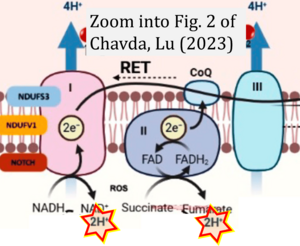Chavda 2023 Antioxidants (Basel)
| Chavda V, Lu B (2023) Reverse electron transport at mitochondrial Complex I in ischemic stroke, aging, and age-related diseases. Antioxidants (Basel) 12:895. https://doi.org/10.3390/antiox12040895 |
Chavda V, Lu B (2023) Antioxidants (Basel)
Abstract: Stroke is one of the leading causes of morbidity and mortality worldwide. A main cause of brain damage by stroke is ischemia-reperfusion (IR) injury due to the increased production of reactive oxygen species (ROS) and energy failure caused by changes in mitochondrial metabolism. Ischemia causes a build-up of succinate in tissues and changes in the mitochondrial NADH: ubiquinone oxidoreductase (complex I) activity that promote reverse electron transfer (RET), in which a portion of the electrons derived from succinate are redirected from ubiquinol along complex I to reach the NADH dehydrogenase module of complex I, where matrix NAD+ is converted to NADH and excessive ROS is produced. RET has been shown to play a role in macrophage activation in response to bacterial infection, electron transport chain reorganization in response to changes in the energy supply, and carotid body adaptation to changes in the oxygen levels. In addition to stroke, deregulated RET and RET-generated ROS (RET-ROS) have been implicated in tissue damage during organ transplantation, whereas an RET-induced NAD+/NADH ratio decrease has been implicated in aging, age-related neurodegeneration, and cancer. In this review, we provide a historical account of the roles of ROS and oxidative damage in the pathogenesis of ischemic stroke, summarize the latest developments in our understanding of RET biology and RET-associated pathological conditions, and discuss new ways to target ischemic stroke, cancer, aging, and age-related neurodegenerative diseases by modulating RET.
• Bioblast editor: Gnaiger E
Hydrogen ion ambiguities in the electron transfer system
Communicated by Gnaiger E (2023-10-08) last update 2023-11-10
- Electron (e-) transfer linked to hydrogen ion (hydron; H+) transfer is a fundamental concept in the field of bioenergetics, critical for understanding redox-coupled energy transformations.
- However, the current literature contains inconsistencies regarding H+ formation on the negative side of bioenergetic membranes, such as the matrix side of the mitochondrial inner membrane, when NADH is oxidized during oxidative phosphorylation (OXPHOS). Ambiguities arise when examining the oxidation of NADH by respiratory Complex I or succinate by Complex II.
- Oxidation of NADH or succinate involves a two-electron transfer of 2{H++e-} to FMN or FAD, respectively. Figures indicating a single electron e- transferred from NADH or succinate lack accuracy.
- The oxidized NAD+ is distinguished from NAD indicating nicotinamide adenine dinucleotide independent of oxidation state.
- NADH + H+ → NAD+ +2{H++e-} is the oxidation half-reaction in this H+-linked electron transfer represented as 2{H++e-} (Gnaiger 2023). Putative H+ formation shown as NADH → NAD+ + H+ conflicts with chemiosmotic coupling stoichiometries between H+ translocation across the coupling membrane and electron transfer to oxygen. Ensuring clarity in this complex field is imperative to tackle the apparent ambiguity crisis and prevent confusion, particularly in light of the increasing number of interdisciplinary publications on bioenergetics concerning diagnostic and clinical applications of OXPHOS analysis.



